Dell Latitude 3500 User Manual

Dell Latitude 3500
Service Manual
Regulatory Model: P86F
Regulatory Type: P86F001
Notes, cautions, and warnings

 NOTE: A NOTE indicates important information that helps you make better use of your product.
NOTE: A NOTE indicates important information that helps you make better use of your product.

 CAUTION: A CAUTION indicates either potential damage to hardware or loss of data and tells you how to avoid the problem.
CAUTION: A CAUTION indicates either potential damage to hardware or loss of data and tells you how to avoid the problem. 
 WARNING: A WARNING indicates a potential for property damage, personal injury, or death.
WARNING: A WARNING indicates a potential for property damage, personal injury, or death.
© 2019 Dell Inc. or its subsidiaries. All rights reserved. Dell, EMC, and other trademarks are trademarks of Dell Inc. or its subsidiaries. Other trademarks may be trademarks of their respective owners.
2019 - 03
Rev. A00

Contents
1 Working on your computer............................................................................................................................. |
5 |
Safety instructions............................................................................................................................................................. |
5 |
Turning o€ your computer — Windows 10..................................................................................................................... |
5 |
Before working inside your computer.............................................................................................................................. |
6 |
After working inside your computer................................................................................................................................. |
6 |
2 Technology and components.......................................................................................................................... |
7 |
DDR4.................................................................................................................................................................................... |
7 |
DDR4 Details................................................................................................................................................................. |
7 |
Memory Errors.............................................................................................................................................................. |
8 |
USB features....................................................................................................................................................................... |
8 |
USB 3.0/USB 3.1 Gen 1 (SuperSpeed USB)............................................................................................................. |
8 |
Speed............................................................................................................................................................................. |
9 |
Applications................................................................................................................................................................... |
9 |
Compatibility................................................................................................................................................................ |
10 |
USB Type-C....................................................................................................................................................................... |
10 |
Alternate Mode........................................................................................................................................................... |
10 |
USB Power Delivery................................................................................................................................................... |
10 |
USB Type-C and USB 3.1........................................................................................................................................... |
10 |
Intel Optane memory......................................................................................................................................................... |
11 |
Enabling Intel Optane memory................................................................................................................................... |
11 |
Disabling Intel Optane memory.................................................................................................................................. |
11 |
Intel UHD Graphics 620................................................................................................................................................... |
12 |
Nvidia GeForce MX130 equivalent................................................................................................................................. |
12 |
3 Removing and installing components............................................................................................................ |
13 |
Recommended tools......................................................................................................................................................... |
13 |
Secure Digital Card..................................................................................................................................................... |
13 |
Base cover................................................................................................................................................................... |
14 |
Battery......................................................................................................................................................................... |
19 |
Hard drive.................................................................................................................................................................... |
23 |
IO board....................................................................................................................................................................... |
27 |
Touchpad..................................................................................................................................................................... |
31 |
Memory modules........................................................................................................................................................ |
37 |
WLAN card................................................................................................................................................................. |
39 |
Solid-state drive/Intel Optane memory module...................................................................................................... |
41 |
Speakers..................................................................................................................................................................... |
50 |
System fan.................................................................................................................................................................. |
54 |
Heat sink..................................................................................................................................................................... |
60 |
VGA daughterboard................................................................................................................................................... |
63 |
Power-button board................................................................................................................................................... |
67 |
System board.............................................................................................................................................................. |
71 |
Display assembly......................................................................................................................................................... |
77 |
Contents 3
Display bezel............................................................................................................................................................... |
86 |
Display panel............................................................................................................................................................... |
90 |
Display hinges............................................................................................................................................................. |
96 |
Display cable............................................................................................................................................................... |
98 |
Camera....................................................................................................................................................................... |
102 |
Palm-rest and keyboard assembly.......................................................................................................................... |
106 |
4 Troubleshooting.......................................................................................................................................... |
108 |
Enhanced Pre-Boot System Assessment — ePSA diagnostics.............................................................................. |
108 |
Running the ePSA Diagnostics............................................................................................................................... |
108 |
Diagnostic LED............................................................................................................................................................... |
109 |
Battery status LED......................................................................................................................................................... |
109 |
5 Getting help................................................................................................................................................. |
111 |
Contacting Dell................................................................................................................................................................. |
111 |
4 Contents

1
Working on your computer
Safety instructions
Prerequisite
Use the following safety guidelines to protect your computer from potential damage and to ensure your personal safety. Unless otherwise noted, each procedure included in this document assumes that the following conditions exist:
•You have read the safety information that shipped with your computer.
•A component can be replaced or, if purchased separately, installed by performing the removal procedure in reverse order.
About this task
WARNING: Disconnect all power sources before opening the computer cover or panels. After you finish working inside the computer, replace all covers, panels, and screws before connecting to the power source.
WARNING: Before working inside your computer, read the safety information that shipped with your computer. For additional safety best practices information, see the Regulatory Compliance Homepage
CAUTION: Many repairs may only be done by a certified service technician. You should only perform troubleshooting and simple repairs as authorized in your product documentation, or as directed by the online or telephone service and support team. Damage due to servicing that is not authorized by Dell is not covered by your warranty. Read and follow the safety instructions that came with the product.
CAUTION: To avoid electrostatic discharge, ground yourself by using a wrist grounding strap or by periodically touching an unpainted metal surface at the same time as touching a connector on the back of the computer.
CAUTION: Handle components and cards with care. Do not touch the components or contacts on a card. Hold a card by its edges or by its metal mounting bracket. Hold a component such as a processor by its edges, not by its pins.
CAUTION: When you disconnect a cable, pull on its connector or on its pull-tab, not on the cable itself. Some cables have connectors with locking tabs; if you are disconnecting this type of cable, press in on the locking tabs before you disconnect the cable. As you pull connectors apart, keep them evenly aligned to avoid bending any connector pins. Also, before you connect a cable, ensure that both connectors are correctly oriented and aligned.

 NOTE: The color of your computer and certain components may appear differently than shown in this document.
NOTE: The color of your computer and certain components may appear differently than shown in this document.
Turning off your computer — Windows 10
About this task
CAUTION: To avoid losing data, save and close all open files and exit all open programs before you turn off your computer or remove the side cover.
Steps
1Click or tap  .
.
2Click or tap  and then click or tap Shut down.
and then click or tap Shut down.
NOTE: Ensure that the computer and all attached devices are turned off. If your computer and attached devices did not automatically turn off when you shut down your operating system, press and hold the power button for about 6 seconds to turn them off.
Working on your computer |
5 |

Before working inside your computer
About this task
To avoid damaging your computer, perform the following steps before you begin working inside the computer.
Steps
1Ensure that you follow the Safety Instruction.
2Ensure that your work surface is ƒat and clean to prevent the computer cover from being scratched.
3Turn o€ your computer.
4Disconnect all network cables from the computer.
CAUTION: To disconnect a network cable, first unplug the cable from your computer and then unplug the cable from the network device.
5Disconnect your computer and all attached devices from their electrical outlets.
6Press and hold the power button while the computer is unplugged to ground the system board.
NOTE: To avoid electrostatic discharge, ground yourself by using a wrist grounding strap or by periodically touching an unpainted metal surface at the same time as touching a connector on the back of the computer.
After working inside your computer
About this task
After you complete any replacement procedure, ensure that you connect any external devices, cards, and cables before turning on your computer.
Steps
1 Connect any telephone or network cables to your computer.
CAUTION: To connect a network cable, first plug the cable into the network device and then plug it into the computer.
2Connect your computer and all attached devices to their electrical outlets.
3Turn on your computer.
4If required, verify that the computer works correctly by running ePSA diagnostics.
6 Working on your computer

2
Technology and components
DDR4
DDR4 (double data rate fourth generation) memory is a higher-speed successor to the DDR2 and DDR3 technologies and allows up to 512 GB in capacity, compared to the DDR3's maximum of 128 GB per DIMM. DDR4 synchronous dynamic random-access memory is keyed di€erently from both SDRAM and DDR to prevent the user from installing the wrong type of memory into the system.
DDR4 needs 20 percent less or just 1.2 volts, compared to DDR3 which requires 1.5 volts of electrical power to operate. DDR4 also supports a new, deep power-down mode that allows the host device to go into standby without needing to refresh its memory. Deep power-down mode is expected to reduce standby power consumption by 40 to 50 percent.
DDR4 Details
There are subtle di€erences between DDR3 and DDR4 memory modules, as listed below.
Key notch di€erence
The key notch on a DDR4 module is in a di€erent location from the key notch on a DDR3 module. Both notches are on the insertion edge but the notch location on the DDR4 is slightly di€erent, to prevent the module from being installed into an incompatible board or platform.
Figure 1. Notch difference
Increased thickness
DDR4 modules are slightly thicker than DDR3, to accommodate more signal layers.
Figure 2. Thickness difference
Curved edge
DDR4 modules feature a curved edge to help with insertion and alleviate stress on the PCB during memory installation.
Technology and components |
7 |

Figure 3. Curved edge
Memory Errors
Memory errors on the system display the new ON-FLASH-FLASH or ON-FLASH-ON failure code. If all memory fails, the LCD does not turn on. Troubleshoot for possible memory failure by trying known good memory modules in the memory connectors on the bottom of the system or under the keyboard, as in some portable systems.

 NOTE: The DDR4 memory is imbedded in board and not a replaceable DIMM as shown and referred.
NOTE: The DDR4 memory is imbedded in board and not a replaceable DIMM as shown and referred.
USB features
Universal Serial Bus, or USB, was introduced in 1996. It dramatically simpli…ed the connection between host computers and peripheral devices like mice, keyboards, external drivers, and printers.
Let's take a quick look on the USB evolution referencing to the table below.
Table 1. USB evolution |
|
|
|
Type |
Data Transfer Rate |
Category |
Introduction Year |
|
|
|
|
USB 2.0 |
480 Mbps |
High Speed |
2000 |
USB 3.0/USB 3.1 Gen 1 |
5 Gbps |
Super Speed |
2010 |
USB 3.1 Gen 2 |
10 Gbps |
Super Speed |
2013 |
USB 3.0/USB 3.1 Gen 1 (SuperSpeed USB)
For years, the USB 2.0 has been …rmly entrenched as the de facto interface standard in the PC world with about 6 billion devices sold, and yet the need for more speed grows by ever faster computing hardware and ever greater bandwidth demands. The USB 3.0/USB 3.1 Gen 1 …nally has the answer to the consumers' demands with a theoretically 10 times faster than its predecessor. In a nutshell, USB 3.1 Gen 1 features are as follows:
•Higher transfer rates (up to 5 Gbps)
•Increased maximum bus power and increased device current draw to better accommodate power-hungry devices
•New power management features
•Full-duplex data transfers and support for new transfer types
•Backward USB 2.0 compatibility
•New connectors and cable
The topics below cover some of the most commonly asked questions regarding USB 3.0/USB 3.1 Gen 1.
8 Technology and components
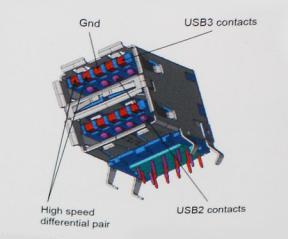
Speed
Currently, there are 3 speed modes de…ned by the latest USB 3.0/USB 3.1 Gen 1 speci…cation. They are Super-Speed, Hi-Speed and FullSpeed. The new SuperSpeed mode has a transfer rate of 4.8Gbps. While the speci…cation retains Hi-Speed, and Full-Speed USB mode, commonly known as USB 2.0 and 1.1 respectively, the slower modes still operate at 480Mbps and 12Mbps respectively and are kept to maintain backward compatibility.
USB 3.0/USB 3.1 Gen 1 achieves the much higher performance by the technical changes below:
•An additional physical bus that is added in parallel with the existing USB 2.0 bus (refer to the picture below).
•USB 2.0 previously had four wires (power, ground, and a pair for di€erential data); USB 3.0/USB 3.1 Gen 1 adds four more for two pairs of di€erential signals (receive and transmit) for a combined total of eight connections in the connectors and cabling.
•USB 3.0/USB 3.1 Gen 1 utilizes the bidirectional data interface, rather than USB 2.0's half-duplex arrangement. This gives a 10-fold increase in theoretical bandwidth.
With today's ever increasing demands placed on data transfers with high-de…nition video content, terabyte storage devices, high megapixel count digital cameras etc., USB 2.0 may not be fast enough. Furthermore, no USB 2.0 connection could ever come close to the 480Mbps theoretical maximum throughput, making data transfer at around 320Mbps (40MB/s) — the actual real-world maximum. Similarly, USB 3.0/USB 3.1 Gen 1 connections will never achieve 4.8Gbps. We will likely see a real-world maximum rate of 400MB/s with overheads. At this speed, USB 3.0/USB 3.1 Gen 1 is a 10x improvement over USB 2.0.
Applications
USB 3.0/USB 3.1 Gen 1 opens up the laneways and provides more headroom for devices to deliver a better overall experience. Where USB video was barely tolerable previously (both from a maximum resolution, latency, and video compression perspective), it's easy to imagine that with 5-10 times the bandwidth available, USB video solutions should work that much better. Single-link DVI requires almost 2Gbps throughput. Where 480Mbps was limiting, 5Gbps is more than promising. With its promised 4.8Gbps speed, the standard will …nd its way into some products that previously weren't USB territory, like external RAID storage systems.
Listed below are some of the available SuperSpeed USB 3.0/USB 3.1 Gen 1 products:
•External Desktop USB 3.0/USB 3.1 Gen 1 Hard Drives
•Portable USB 3.0/USB 3.1 Gen 1 Hard Drives
•USB 3.0/USB 3.1 Gen 1 Drive Docks & Adapters
•USB 3.0/USB 3.1 Gen 1 Flash Drives & Readers
•USB 3.0/USB 3.1 Gen 1 Solid-state Drives
Technology and components |
9 |
•USB 3.0/USB 3.1 Gen 1 RAIDs
•Optical Media Drives
•Multimedia Devices
•Networking
•USB 3.0/USB 3.1 Gen 1 Adapter Cards & Hubs
Compatibility
The good news is that USB 3.0/USB 3.1 Gen 1 has been carefully planned from the start to peacefully co-exist with USB 2.0. First of all, while USB 3.0/USB 3.1 Gen 1 speci…es new physical connections and thus new cables to take advantage of the higher speed capability of the new protocol, the connector itself remains the same rectangular shape with the four USB 2.0 contacts in the exact same location as before. Five new connections to carry receive and transmitted data independently are present on USB 3.0/USB 3.1 Gen 1 cables and only come into contact when connected to a proper SuperSpeed USB connection.
Windows 8/10 will be bringing native support for USB 3.1 Gen 1 controllers. This is in contrast to previous versions of Windows, which continue to require separate drivers for USB 3.0/USB 3.1 Gen 1 controllers.
Microsoft announced that Windows 7 would have USB 3.1 Gen 1 support, perhaps not on its immediate release, but in a subsequent Service Pack or update. It is not out of the question to think that following a successful release of USB 3.0/USB 3.1 Gen 1 support in Windows 7, SuperSpeed support would trickle down to Vista. Microsoft has con…rmed this by stating that most of their partners share the opinion that Vista should also support USB 3.0/USB 3.1 Gen 1.
USB Type-C
USB Type-C is a new, tiny physical connector. The connector itself can support various exciting new USB standard like USB 3.1 and USB power delivery (USB PD).
Alternate Mode
USB Type-C is a new connector standard that's very small. It's about a third the size of an old USB Type-A plug. This is a single connector standard that every device should be able to use. USB Type-C ports can support a variety of di€erent protocols using “alternate modes,” which allows you to have adapters that can output HDMI, VGA, DisplayPort, or other types of connections from that single USB port
USB Power Delivery
The USB PD speci…cation is also closely intertwined with USB Type-C. Currently, smartphones, tablets, and other mobile devices often use a USB connection to charge. A USB 2.0 connection provides up to 2.5 watts of power — that'll charge your phone, but that's about it. A laptop might require up to 60 watts, for example. The USB Power Delivery speci…cation ups this power delivery to 100 watts. It's bidirectional, so a device can either send or receive power. And this power can be transferred at the same time the device is transmitting data across the connection.
This could spell the end of all those proprietary laptop charging cables, with everything charging via a standard USB connection. You could charge your laptop from one of those portable battery packs you charge your smartphones and other portable devices from today. You could plug your laptop into an external display connected to a power cable, and that external display would charge your laptop as you used it as an external display — all via the one little USB Type-C connection. To use this, the device and the cable have to support USB Power Delivery. Just having a USB Type-C connection doesn't necessarily mean they do.
USB Type-C and USB 3.1
USB 3.1 is a new USB standard. USB 3's theoretical bandwidth is 5 Gbps, while USB 3.1 Gen2 is10Gbps . That's double the bandwidth, as fast as a …rst-generation Thunderbolt connector. USB Type-C isn't the same thing as USB 3.1. USB Type-C is just a connector shape, and
10 Technology and components

the underlying technology could just be USB 2 or USB 3.0. In fact, Nokia's N1 Android tablet uses a USB Type-C connector, but underneath it's all USB 2.0 — not even USB 3.0. However, these technologies are closely related.
Intel Optane memory
Intel Optane memory functions only as a storage accelerator. It neither replaces nor adds to the memory (RAM) installed on your computer.
NOTE: Intel Optane memory is supported on computers that meet the following requirements:
•7th Generation or higher Intel Core i3/i5/i7 processor
•Windows 10 64-bit version or higher
•Intel Rapid Storage Technology driver version 15.9.1.1018 or higher
Table 2. Intel Optane memory specifications |
|
Feature |
Specifications |
|
|
Interface |
PCIe 3x2 NVMe 1.1 |
Connector |
M.2 card slot (2230/2280) |
Con…gurations supported |
• 7th Generation or higher Intel Core i3/i5/i7 processor |
|
|
|
• Windows 10 64-bit version or higher |
|
• Intel Rapid Storage Technology driver version 15.9.1.1018 or |
|
higher |
Capacity |
16 GB |
Enabling Intel Optane memory
1On the taskbar, click the search box, and type "Intel Rapid Storage Technology".
2Click Intel Rapid Storage Technology.
3On the Status tab, click Enable to enable the Intel Optane memory.
4On the warning screen, select a compatible fast drive, and then click Yes to continue enabling Intel Optane memory.
5Click Intel Optane memory > Reboot to enable the Intel Optane memory.

 NOTE: Applications may take up to three subsequent launches after enablement to see the full performance benefits.
NOTE: Applications may take up to three subsequent launches after enablement to see the full performance benefits.
Disabling Intel Optane memory
About this task
CAUTION: After disabling Intel Optane memory, do not uninstall the driver for Intel Rapid Storage Technology as it will result in a blue screen error. The Intel Rapid Storage Technology user interface can be removed without uninstalling the driver.
NOTE: Disabling Intel Optane memory is required before removing the SATA storage device, accelerated by the Intel Optane memory module, from the computer.
Steps
1On the taskbar, click the search box, and then type "Intel Rapid Storage Technology".
2Click Intel Rapid Storage Technology. The Intel Rapid Storage Technology window is displayed.
3On the Intel Optane memory tab, click Disable to disable the Intel Optane memory.
4Click Yes if you accept the warning. The disabling progress is displayed.
5Click Reboot to complete disabling Intel Optane memory and restart your computer.
Technology and components |
11 |

Intel UHD Graphics 620
Table 3. Intel UHD Graphics 620 specifications
Intel UHD Graphics 620
Bus Type |
Integrated |
Memory Type |
DDR4 |
Graphics Level |
i3/i5/i7: G T2 (UHD 620) |
Estimated Maximum Power Consumption (TDP) |
15 W (included in the CPU power) |
Overlay Planes |
Yes |
Operating Systems Graphics/ Video API Support |
DirectX 11 (Windows 7/8.1), DirectX 12 (Windows 10), OpenGL 4.3 |
Maximum Vertical Refresh Rate |
Up to 85 Hz depending on resolution |
Multiple Display Support |
On System: eDP (internal), HDMI |
|
Via Optional USB Type-C Port: VGA, DisplayPort |
External Connectors |
HDMI 1.4b |
|
USB Type–C port |
Nvidia GeForce MX130 equivalent
Table 4. Nvidia GeForce MX130 specifications |
|
Feature |
Specifications |
|
|
Graphics memory |
2 GB GDDR5 |
Bus type |
PCI Express 3.0 |
Memory Interface |
GDDR5 |
Clock Speeds |
1122 - 1242 (Boost) MHz |
Maximum Color Depth |
N/A |
Maximum Vertical Refresh Rate |
N/A |
Operating Systems Graphics/ Video API Support |
Windows 10/ DX 12/ OGL4.5 |
Supported Resolutions and Max Refresh Rates (Hz) |
N/A |
Numbers of Display Support |
No display output from MX130 |
12 Technology and components
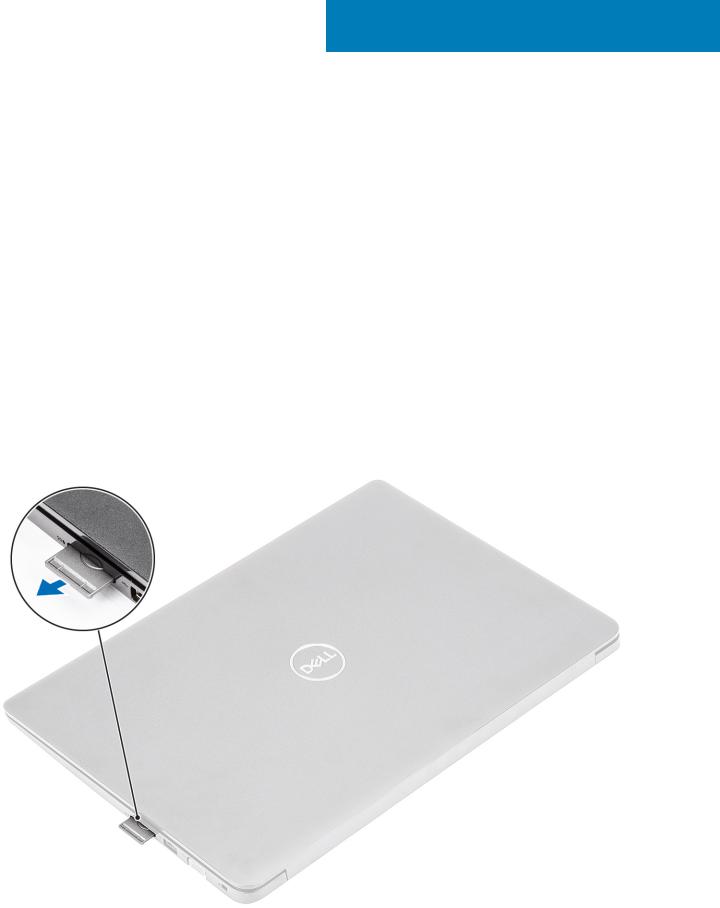
3
Removing and installing components
Recommended tools
The procedures in this document require the following tools:
•Phillips #0 screwdriver
•Phillips #1 screwdriver
•Plastic scribe

 NOTE: The #0 screw driver is for screws 0-1 and the #1 screw driver is for screws 2-4
NOTE: The #0 screw driver is for screws 0-1 and the #1 screw driver is for screws 2-4
Secure Digital Card
Removing the Secure Digital card
Prerequisite
1 Follow the procedure in Before working inside your computer
Steps
1Push the secure digital card to release it from the computer.
2Slide the secure digital card out of the computer.
Removing and installing components |
13 |
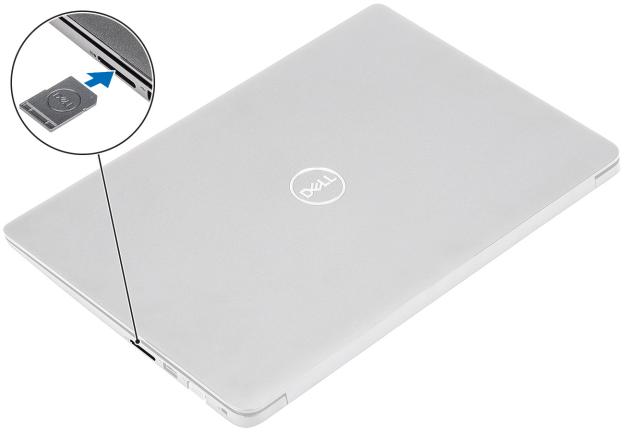
Installing the Secure Digital card
1Slide the secure digital into the slot until it clicks into place.
2Follow the procedures in After working inside your computer.
Base cover
Removing the base cover
Prerequisites
1Follow the procedure in before working inside your computer
2Remove the SD memory card
Steps
1 Loosen the ten captive screws that secure the base cover to the palmrest and keyboard assembly.
14 Removing and installing components

2 Pry the base cover and continue to open the right side of the base cover.
Removing and installing components |
15 |
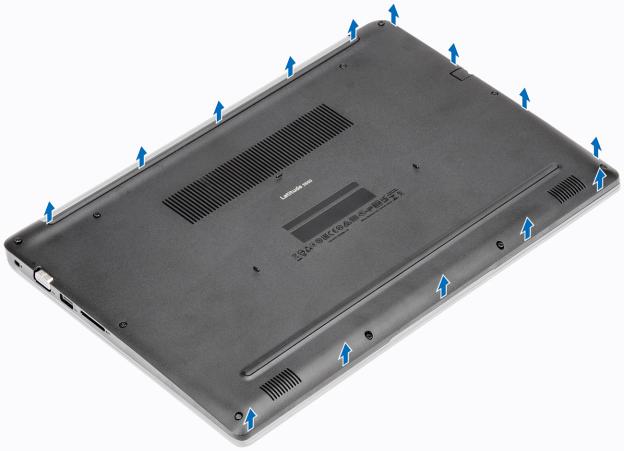
3 Lift the right side of the base cover [1], and remove it o€ the palmrest and keyboard assembly [2].
16 Removing and installing components
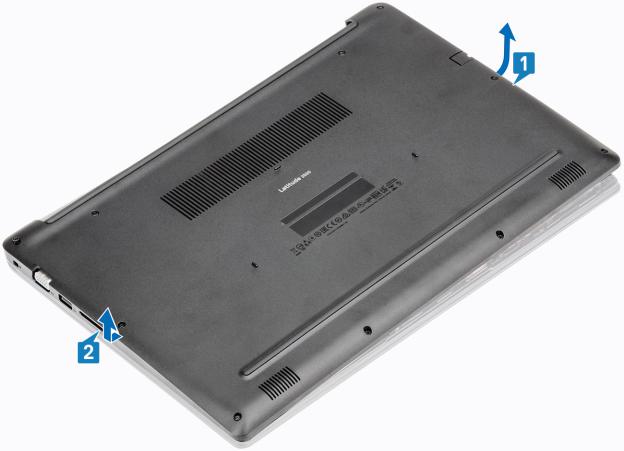
Installing the base cover
Steps
1 Place the base cover on the palmrest and keyboard assembly [1].
Removing and installing components |
17 |
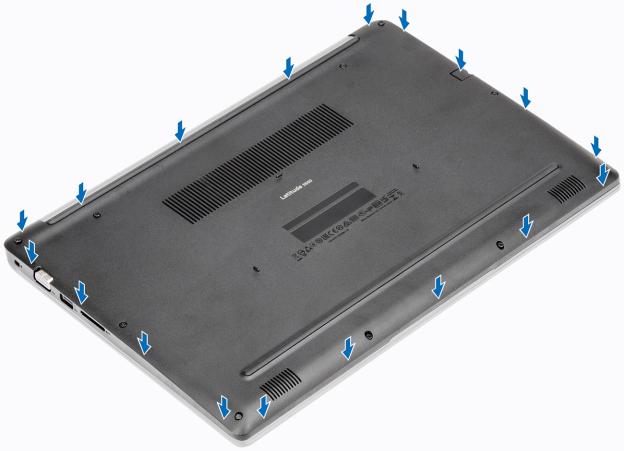
2 Tighten the ten captive screws that secure the base cover to the palmrest and keyboard assembly.
18 Removing and installing components
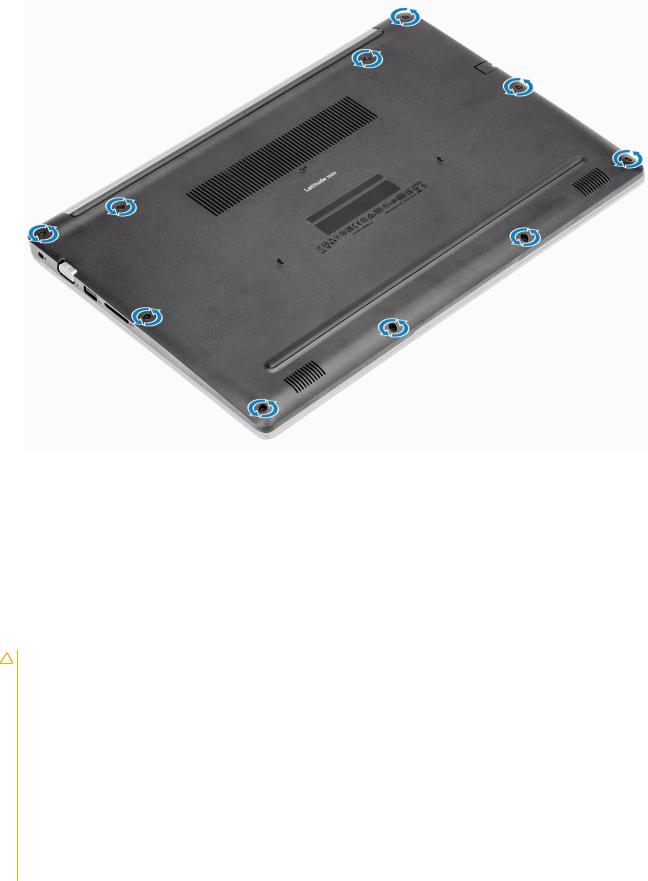
Next steps
1Replace the SD memory card
2Follow the procedure in after working inside your computer
Battery
Lithium-ion battery precautions
CAUTION:
•Exercise caution when handling Lithium-ion batteries.
•Discharge the battery as much as possible before removing it from the system. This can be done by disconnecting the AC adapter from the system to allow the battery to drain.
•Do not crush, drop, mutilate, or penetrate the battery with foreign objects.
•Do not expose the battery to high temperatures, or disassemble battery packs and cells.
•Do not apply pressure to the surface of the battery.
•Do not bend the battery.
•Do not use tools of any kind to pry on or against the battery.
•If a battery gets stuck in a device as a result of swelling, do not try to free it as puncturing, bending, or crushing a Lithium-ion battery can be dangerous. In such an instance, the entire system should be replaced. Contact https://www.dell.com/support for assistance and further instructions.
•Always purchase genuine batteries from https://www.dell.com or authorized Dell partners and re-sellers.
Removing and installing components |
19 |

Removing the battery
Prerequisites
1Follow the procedure in before working inside your computer
2Remove the SD memory card
3Remove the base cover
Steps
1 Disconnect the battery cable from the system board.
2Remove the four (M2x3) screws that secure the battery to the palmrest and keyboard assembly [1].
3Lift the battery o€ the palmrest and keyboard assembly [2].
20 Removing and installing components
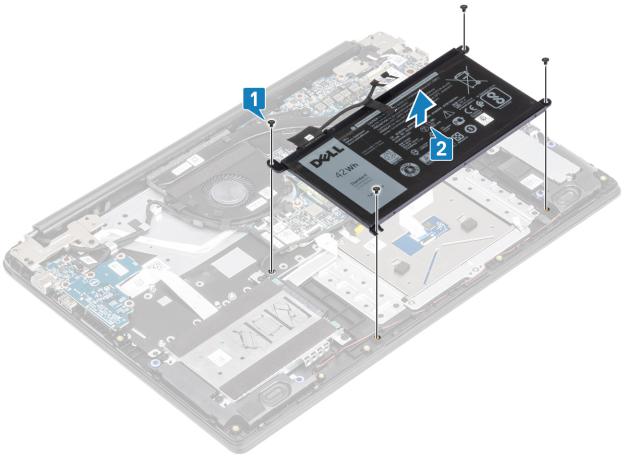
Installing the battery
Steps
1Align the screw holes on the battery with the screw holes on the palmrest and keyboard assembly [1].
2Replace the four (M2x3) screws that secure the battery to the palmrest and keyboard assembly [2].
Removing and installing components |
21 |
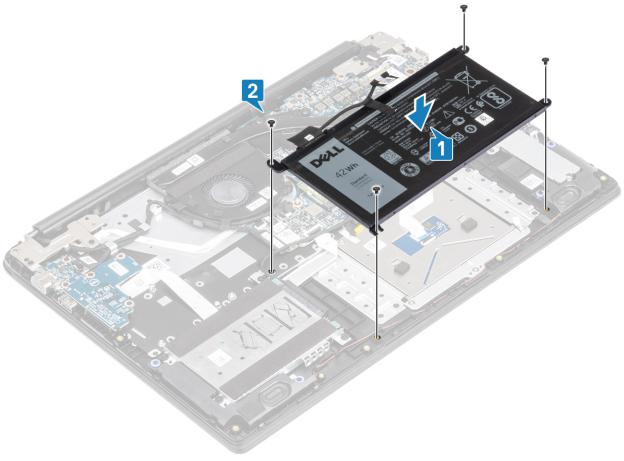
3 Connect the battery cable to the system board.
22 Removing and installing components
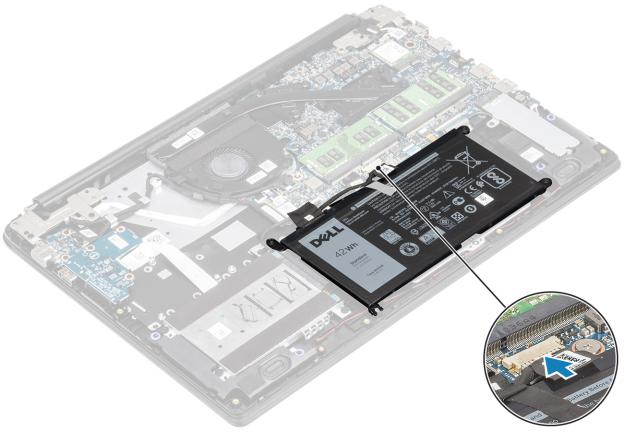
Next steps
1Replace the base cover
2Replace the SD memory card
3Follow the procedure in after working inside your computer
Hard drive
Removing the hard drive assembly
Prerequisites
1Follow the procedure in before working inside your computer
2Remove the SD memory card
3Remove the base cover
4Remove the battery
Steps
1Disconnect the hard drive cable from the system board [1].
2Peel the tape that secures the hard drive cable to the palmrest and keyboard assembly [2].
Removing and installing components |
23 |
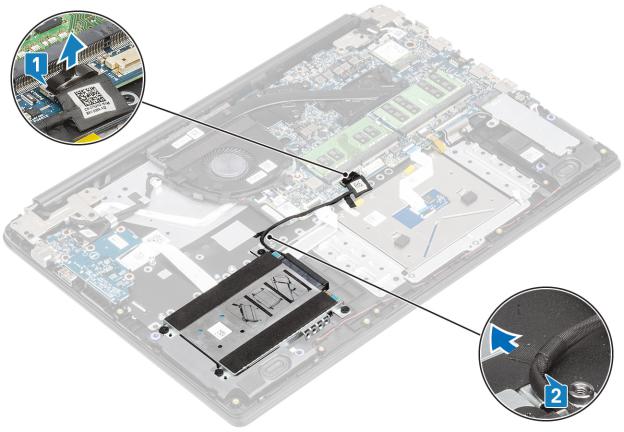
3Remove the four (M2x4) screws that secure the hard drive assembly to the palmrest and keyboard assembly [1].
4Lift the hard drive from the slot on the palmrest and keyboard assembly [2].
24 Removing and installing components
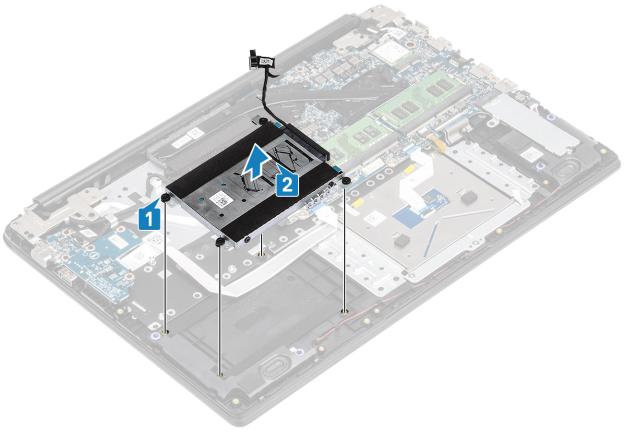
Installing the hard drive assembly
Steps
1Align the screw holes on the hard drive assembly with the screw holes on the palm rest and keyboard assembly [1].
2Replace the four (M2x4) screws that secure the hard drive assembly to the palm rest and keyboard assembly [2].
Removing and installing components |
25 |

3Adhere the tape that secures the hard drive cable to the palmrest and keyboard assembly [1].
4Connect the hard drive cable to the system board [2].
26 Removing and installing components
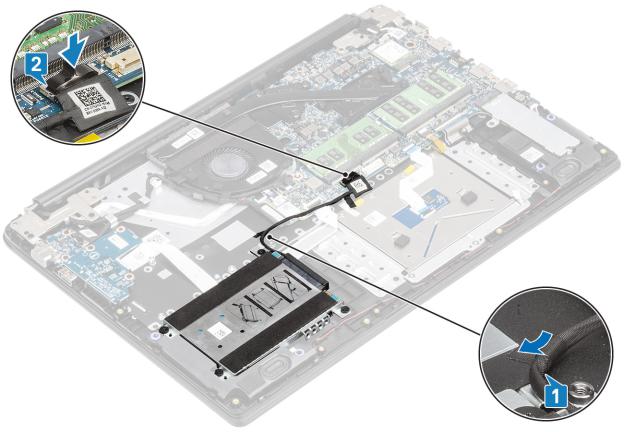
Next steps
1Replace the battery
2Replace the base cover
3Replace the SD memory card
4Follow the procedure in after working inside your computer
IO board
Removing the IO board
Prerequisites
1Follow the procedure in before working inside your computer
2Remove the SD memory card
3Remove the base cover
4Remove the battery
5Remove the hard drive assembly
Steps
1Open the latch and disconnect the I/O board cable from the system board [1].
2Peel the I/O-board cable from the palm rest and keyboard assembly [2].
Removing and installing components |
27 |
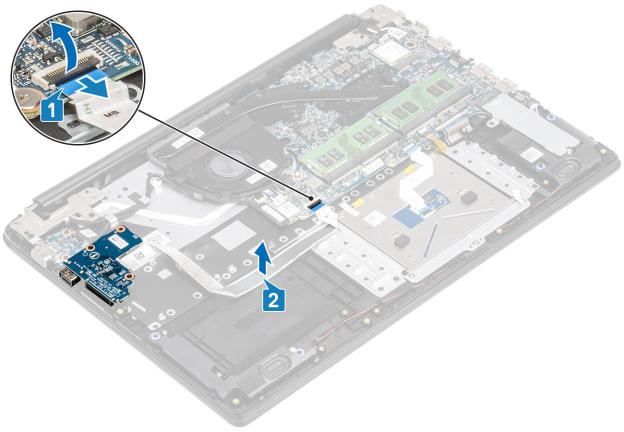
3Remove the two (M2x3) screws that secure the I/O board to the palm rest and keyboard assembly [1].
4Lift the I/O board, along with the cable, o€ the palm rest and keyboard assembly [2].
28 Removing and installing components
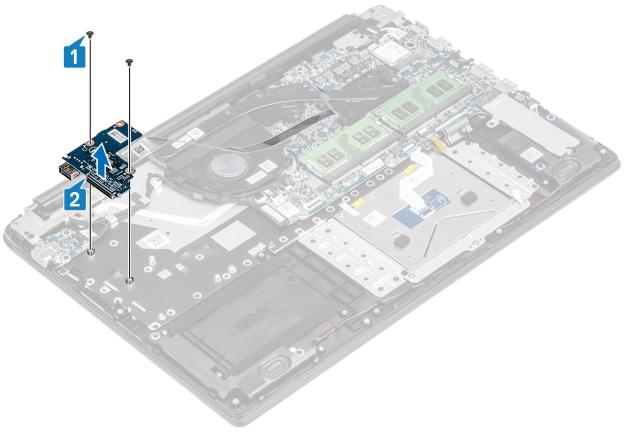
Installing the IO board
Steps
1Using the alignment posts, place the I/O board on the palm rest and keyboard assembly [1].
2Replace the two (M2x3) screws that secure the I/O board to the palm rest and keyboard assembly [2].
Removing and installing components |
29 |

3Adhere the I/O board cable to the palm rest and keyboard assembly [1].
4Connect the I/O board cable to the system board and close the latch to secure the cable [2].
30 Removing and installing components
